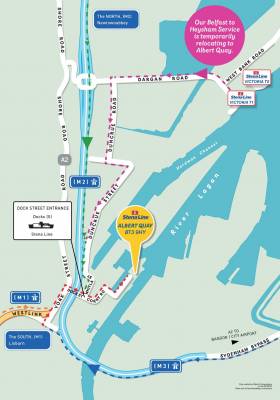Displaying items by tag: Albert Quay
Stena Line to Temporarily Relocate Belfast-Heysham Service Terminal in Belfast Harbour
In preparation for the arrival of Stena Line’s new generation E-Flexer ships as Afloat previously reported onto the Belfast-Liverpool service in 2020/21, the company has announced the need to make a number of important infrastructure upgrade changes in Belfast Harbour.
According to the operator this involves Victoria Terminal 2 (VT2) where the arrival of the first new vessel (on this route) Stena Edda is scheduled in Spring 2020.
To minimise customer disruption and inconvenience whilst this work is being carried out, Stena Line has made temporary arrangements to relocate its Belfast – Heysham Service to Albert Dock/Ballast Quay for approximately 6 months, starting this week on Friday 14th June, 2019.
Anna Breen, Stena Line’s Freight Commercial Mangere (Irish Sea North) said: “ Whilst we fully appreciate the slight inconvenience this may cause, Albert Dock/Ballast Quay is a facility we have used before and are very familiar with so we will do all we can to minimise any possible inconvenience to our customers. As we invest and grow our business on the Belfast -Liverpool service, the new E-Flexers will provide an additional 20% freight capacity, hopefully this will provide even greater business development opportunities for our customers in the years ahead. Stena Line has a proven track record of investing in its ships and ports and nowhere is this more evident than in our expanding Belfast Hub. “
A map (as above) outlines the most convenient way to access the new temporary facility at Albert Quay (located closer to Belfast city centre).
Customers who require further information or clarification are advised to contact the Stena Line Customer Service Team on 0845 0704000
A Weekend to Explore the 'Bounty'
The Cork-berthed replica HMS Bounty, the purpose built movie prop tallship used in the 1962 MGM studies film release of 'Mutiny and the Bounty' starring Marlon Brando, will be open to visitors from tomorrow, writes Jehan Ashmore.
The famous tall ship is to open to the public between (11am-6pm) and these times also apply to the Saturday and Sunday. Tours on board the Bounty are self-guided with crew assistance. Admission charges are €10 for adults and children €5, children under four years go free.
The Bounty is berthed at Albert Quay which faces opposite the Cork City Marina on the south quays of the city-centre.
The public can explore her "tween" deck 8' foot ceilings, this made it easier for the film crew and their equipment to access.
As a result, Bounty has been hired by filmcrews for the making of 'Treasure Island', 'Yellowbeard', 'Sponge Bob, Square Pants, the Movie' and 'Pirates of the Caribbean - Dead Man's Chest'. In addition to commercial movies, Bounty has also been the stage for many documentaries.
To compare the differences between the replica and the original 18th century built 'Bounty' click HERE.






























































